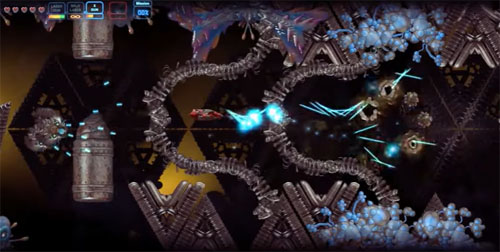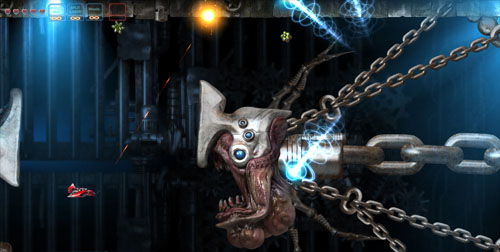A game by Next Game Level for PC, Switch, PS4, PS5, Xbox One, and Xbox X/S, originally released in 2019.
Remote Life is a horizontal shmup with independent movement and aiming, blending auto-scrolling shooter action with twin-stick combat. The game takes place in the year 2324, and Earth is under threat from a gigantic alien hive that is slowly approaching the planet. A distant space station has already been consumed by the alien menace, and in two months’ time, the hive will be on Earth’s doorstep. After a failed attempt to teleport into the hive itself, another ship is teleported just outside it. You take on the role of pilot John Leone as he fights his way through dark densely-packed corridors full of moving machinery, alien pests, and grotesque boss creatures.The game is presented using 3D pre-rendered sprites, giving it a unique visual style… it’s like Donkey Kong Country, except instead of exploring a bright and colorful jungle full of playful enemies, you’re enduring the ongoing punishment of H.R. Giger’s wet dream while surrounded by creatures that look like they could devour your soul, while an intense soundtrack pushes you ever forward. Unfortunately, all of the dialogue is spewed out by a text-to-speech reader, so the narrative experience is wholly devoid of weight or emotion.
When the game begins, you find yourself in control of a slow-moving ship. Two other playable ships are unlocked early into the experience, with each offering slightly faster movement, but otherwise no additional advantages. The default difficulty mode is Easy, although players without sharp shmup skills may still find this mode to be challenging, while shmup veterans should try their hands at Medium, Hard, or Very Hard modes. Also unlockable is a gallery featuring some of the game’s artwork and unused concepts, as well as the promise of being able to “customize your own monster snake” in a late-game unlock.
A tutorial is offered to get you used to the non-standard shmup controls, but you have the option of skipping this, along with the prologue and introductory staging mission. There are 16 missions in all, and 20+ weapons to use along the way, although collecting new weapons isn’t just a matter of replacing your existing armaments or increasing their power. Instead, your primary weapons are divided into A, B, and C classes, which you must cyle through, while your heavy weapon (Class D) is assigned to its own button.
The A, B, and C weapons all have weaker infinite ammo variants, and you start the game with these downgraded versions. As you collect powerups, they are loaded into the A, B, or C slots, and these have limited ammo (as indicated by a meter), after which you return to the weaker versions. The weaker weapons consist of a gatling gun with small fast-moving projectiles that fire in a straight line, a split laser that fires a 3-way shot with the outer projectiles moving in a wave formation, and missiles that have a medium speed and wider firing range.
What makes things unique is that each weapon pickup is assigned to a different class. Picking up a Class A weapon will drop it in the corresponding slot, taking the place of whatever weapon was equipped there. Given the wide array of weapons, it takes a while before you’ll know which ones are better suited to your situation or playstyle, but it’s difficult to keep track of the various weapon types in the heat of battle. Fortunately, pickups tend to be frequent, and your default infinite-ammo weapons are pretty decent, so you’re generally encouraged to just keep firing… while possibly holding onto one of your big guns for a big baddie or a boss fight.
The A, B, and C classes generally indicate what kind of projectile to expect, with the A-class mostly offering projectiles that fire in a straight line, B-class offering a slightly wider range, and C-class offering more power. The D-class weapon is there when you need to do a bunch of damage over a wide area, but even this weapon comes in multiple varieties, rather than just being a basic smart bomb. For instance, the cluster bomb fires a powerful missile that drops a bunch of smaller bombs as it goes, while mines are effective against enemies coming up from behind, and the neutron bomb offers a more traditional gigantic explosion that slowly extends outward. As expected, ammo capacity for D-class weapons is much lower than the other weapon types.
More importantly, all of the A-, B-, and C-class weapons may be aimed freely, allowing you to target enemies in all directions. While most enemies attack from the front, you are constantly in situations where you’re surrounded by danger and must fire in every direction to make your way through. Unfortunately, there is no option to automatically fire when aiming (which is typical in many twin stick shooters), so you’ll need to aim and also hold the trigger… but all of these weapons offer continuous fire. There are some supplemental weapons as well, such as hovering Gradius-style options that give you extra firepower for 30 seconds, the occasional stationary turret that mimics your aiming, and the rare 5-second super weapon that can shoot through walls and destroy everything almost immediately.
A lot of the navigable passages are quite narrow and often filled with moving machinery that compounds the danger. Most of the time, you’re just as likely to be killed by running into a wall as you are by enemies. It doesn’t help that the palette consists of mostly dull and metallic colors, causing some enemies, obstacles, and projectiles to blend together, thereby resulting in some unexpected deaths, especially since some enemies can shoot through walls. Fortunately, you can shoot down most projectiles, but some are so tiny that you may not notice them until your ship explodes. A lot of the explosions, lighting, and other effects can also be pretty intense, which adds to the feeling of action and chaos, but it can also be overwhelming at times… however, these effects can be dialed back in the Options menu.
Every hit from an enemy or obstacle spells instant death, but you have five units of health. Rather than allowing you to absorb five hits, your health meter is actually a lives system. Each time you take damage, your ship is destroyed, and then it respawns with a lengthy temporary invincibility period. This allows you to move out of danger – or even fly through walls or other environmental hazards – but if you lose all five units of health, you have to start the stage from the beginning. This is the case even if you are killed during a boss encounter, which can make the experience more frustrating.
You are able to collect hearts to replace one unit of lost health, but these are dropped infrequently. You also don’t receive a health restoration when completing a level or defeating a boss, so unless you’re holding on to some really precious ammo that you’d like to carry into the next level, you’re better off killing yourself so you can respawn with full health. There is no scoring system or other apparent advantage to staying alive from one level to the next, and losing all of your health returns you to a level select screen. This is a bit clunky since you have to scroll a cursor back to the level you were just on, click it, wait for a bit of artwork to appear, then click again to actually make the level load. In this genre, the player would typically be warped back to the start of the level to try again immediately.
For the most part, the pace of the game is quite slow. The screen scrolls slowly, so you’re often targeting enemies quite a distance away from you, or waiting for a door to open so you can start dealing damage to enemies on the other side, but there are bouts of action when lots of enemies close in at once, or when you’re in a claustrophobic area trying to shoot down multiple baddies while keeping your ship away from the walls.
Boss battles are full of fire and fury – and these are clearly the showpieces of the game, with varying and unique designs for each – but they tend to be untechnical affairs, focusing mainly on dealing lots of damage to one or more weak points rather than requiring any kind of strategy. Often, if you’ve saved a powerful weapon for the end of the level, you can bring these hulking creatures down before they’ve had much of an opportunity to do much of anything, which removes some of the excitement from these battles. On the other hand, when you don’t know how a boss is going to attack, and it quickly wipes out your remaining health, you are then forced to sit through the full length of a slow-crawling level to get back to the boss and try again.
Gameplay gets a few shots of variety here and there, with the player occasionally controlling a powerful mobile weapons platform to slice through enemies with ease, along with a few not-as-bad-as-you’d-think escort missions. One level changes things up by having you navigate through a darkened area, using only your ship’s light view your surroundings… but most environmental obstacles fall away after you leave the opening area, leading to a pretty slow-paced level with a lower than normal number of enemy encounters.
More exciting are the free exploration levels where you fly around an open environment killing enemies and hunting down objectives, while using a minimap to guide your progress. These areas really take advantage of your ability to move and fire in every direction, and you get to control the pace – and therefore the risk and reward – as you flit about and explore every corner of the level. These areas also expand upon the narrative a bit, as you learn what other operatives are doing to assist you in your mission.
There is also some strategy to how you use your weapon in certain environments, as destroyed alien eggs will hatch and send small creatures moving toward you, and some floating mine-like objects will split in two and move when fired upon, potentially turning a small threat into a large one if you go guns-hot into every situation.
2D CRED
Remote Life was developed by Next Game Level, a one-person studio headed by Mario Malagrino and based in Florence, Italy. This was his first commercial release.
Console versions of the game were ported and published by Ratalaika Games. The studio has published dozens of games, including Sun Wukong vs Robot, Even the Ocean, Metagal, and Garlic.





























0 comments:
Post a Comment